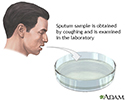Sputum Gram stain
Gram stain of sputumA sputum Gram stain is a lab test used to detect bacteria in a sputum sample. Sputum is the material that comes up from your air passages when you cough very deeply.
The Gram stain method is one of the most commonly used methods to rapidly identify the type of bacteria in a bacterial infection, including pneumonia.
Gram stain method
A Gram stain is a test used to identify bacteria. It is one of the most common ways to quickly diagnose bacterial infection in the body.

How the Test is Performed
A sputum sample is needed.
- You will be asked to cough deeply and spit any substance that comes up from your lungs (sputum) into a special container.
- You may be asked to breathe in a mist of salty steam. This makes you cough more deeply and produce sputum.
- If you still do not produce enough sputum, you might have a procedure called bronchoscopy.
Bronchoscopy
Bronchoscopy is a test to view the airways and diagnose lung disease. It may also be used during the treatment of some lung conditions.
 ImageRead Article Now Book Mark Article
ImageRead Article Now Book Mark Article - To increase the accuracy, this test is sometimes done 3 times, often 3 days in a row.
The sample is sent to a lab. The lab team member places a very thin layer of the sample onto a glass slide. This is called a smear. Stains are placed on the sample. The lab team member looks at the stained slide under a microscope, checking for bacteria and white blood cells. The color, size, and shape of the cells help identify the bacteria.
How to Prepare for the Test
Drinking fluids the night before the test may help your lungs produce phlegm. It makes the test more accurate if it is done first thing in the morning.
If you are having a bronchoscopy, follow your health care provider's instructions on how to prepare for the procedure.
How the Test will Feel
There is no discomfort, unless a bronchoscopy needs to be performed.
Why the Test is Performed
Your provider may order this test if you have a persistent or prolonged cough, or if you are coughing up material that has a foul odor or unusual color. The test may also be done if you have other signs and symptoms of a respiratory disease or an infection.
Normal Results
A normal result means that few to no white blood cells and no bacteria were seen in the sample. The sputum is clear, thin, and odorless.
What Abnormal Results Mean
An abnormal result means that bacteria are seen in the test sample. You may have a bacterial infection. A culture is needed to confirm the diagnosis.
Risks
There are no risks, unless bronchoscopy is performed.
References
Dockrell DH, Ho A, Gordon SB. Community-acquired pneumonia. In: Broaddus VC, Ernst JD, King TE, et al, eds. Murray and Nadel's Textbook of Respiratory Medicine. 7th ed. Philadelphia, PA: Elsevier; 2022:chap 46.
Plourde AR, Beavis KG. Specimen collection and handling for diagnosis of infectious diseases. In: McPherson RA, Pincus MR, eds. Henry's Clinical Diagnosis and Management by Laboratory Methods. 24th ed. Philadelphia, PA: Elsevier; 2022:chap 66.
-
Sputum test - illustration
A sputum sample is obtained by coughing deeply and expelling the material that comes from the lungs into a sterile cup. The sample is taken to a laboratory and placed in a medium under conditions that allow the organisms to grow. A positive culture may identify disease-producing organisms that may help diagnose bronchitis, tuberculosis, a lung abscess, or pneumonia.
Sputum test
illustration
-
Sputum test - illustration
A sputum sample is obtained by coughing deeply and expelling the material that comes from the lungs into a sterile cup. The sample is taken to a laboratory and placed in a medium under conditions that allow the organisms to grow. A positive culture may identify disease-producing organisms that may help diagnose bronchitis, tuberculosis, a lung abscess, or pneumonia.
Sputum test
illustration
Review Date: 10/11/2024
Reviewed By: Frank D. Brodkey, MD, FCCM, Associate Professor, Section of Pulmonary and Critical Care Medicine, University of Wisconsin School of Medicine and Public Health, Madison, WI. Also reviewed by David C. Dugdale, MD, Medical Director, Brenda Conaway, Editorial Director, and the A.D.A.M. Editorial team.


